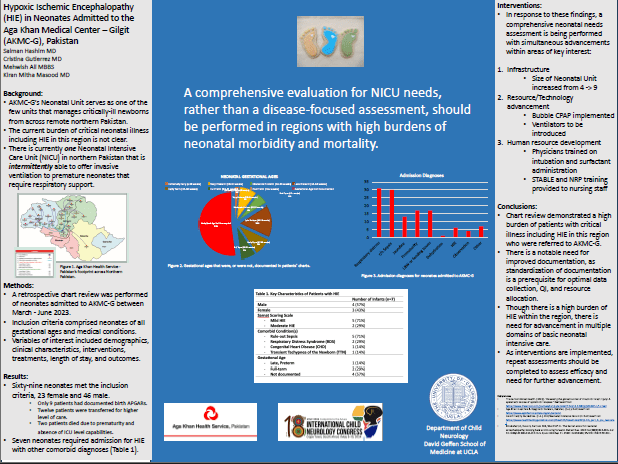Incidence Of Hypoxic Ischemic Encephalopathy (HIE) In Neonates Admitted To The Aga Khan Medical Center – Gilgit (AKMC-G)
Background: Hypoxic ischemic encephalopathy (HIE) causes severe disability for newborns in Pakistan. The AKMC-G Neonatal Unit serves as one of the few centers that manages critically-ill newborns in remote Northern Pakistan. The current burden of HIE in this region is unknown. Methods: A retrospective chart review was performed of neonates admitted to AKMC-G between March - June 2023. Inclusion criteria comprised neonates of all gestational ages and medical conditions. Variables of interest included demographics, clinical characteristics, length of stay, and outcomes. Data analysis was performed using Microsoft Excel, v16.76. Results: Sixty-nine neonates met the inclusion criteria during the study period. Seven neonates (10%) required admission for HIE (see Table 1) with other comorbid diagnoses. Of these patients, 2 were full-term, 1 was late pre-term, and the remaining did not have documented gestational ages. Five neonates (71%) had mild HIE per modified Sarnat Scoring. Two had moderate HIE (29%) with seizures, and had additional imaging (ultrasound [n=2] and head CT [n=1]). One patient had documented birth APGARs. One patient required transfer for higher level of care, otherwise all patients were discharged home. Interpretation: Chart review demonstrated a high burden of HIE in this region. Additionally, there is a need for improved documentation. From these findings, a comprehensive neonatal admission template was developed for AKMC-G. Resident travel grant received.
Salman Hashim
UCLA Mattel Childrens Hospital
United States
Mahvish Ali
Aga Khan Medical Center, Pakistan
Pakistan
Kiran Mitha Masood
UCLA Mattel Childrens Hospital
United States

Salman Hashim
UCLA Mattel Childrens Hospital
United States